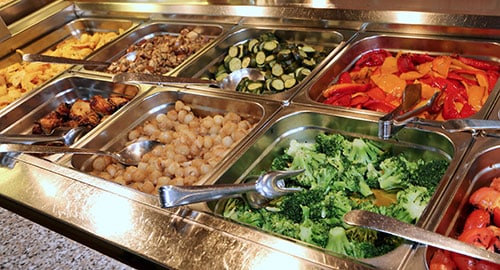
Priority Nutrition Strategy: Food Service and Nutrition Guidelines
Promote food service and nutrition guidelines and associated healthy food procurement systems in facilities, programs, or organizations where food is sold, served, or distributed.
Background
Healthy eating patterns help people live longer, strengthen their immune systems, and have fewer chronic diseases. However, many groups of people have limited access to affordable healthy foods, such as fruits and vegetables. People living in lower-income urban neighborhoods, rural areas, and tribal communities, as well some racial and ethnic groups often lack access to affordable, convenient places that offer healthier foods. In 2021, nearly 34 million people lived in food insecure households.
Healthy eating emphasizes fruits, vegetables, whole grains, low-fat or fat-free dairy, and lean protein and limits added sugar, saturated fat, and sodium. However, in 2019, only about 1 in 10 US adults met recommendations for fruit and vegetable intake. Among adolescents, 7% met the recommendation for fruits, while only 2% met the recommendation for vegetables. In addition, federal guidelines [PDF-30.7MB] recommend that Americans 2 years and older keep their intake of added sugars to less than 10% of their total daily calories. That means that in a 2,000-calorie diet, no more than 200 calories—about 12 teaspoons—should come from added sugars. Yet in 2017–2018, the average intake of added sugars was 17 teaspoons for children and adults.
When healthy items are not readily available, people may settle for unhealthy foods. States and communities can improve access to healthy foods in a variety of ways. Applying food service or nutrition guidelines such as the Food Service Guidelines for Federal Facilities [PDF-3.3MB] (federal food service guidelines) in worksites and community settings or the Healthy Eating Research Nutrition Guidelines for the Charitable Food System [PDF-4.1MB] (HER guidelines) in food banks and pantries can improve healthy food access where foods and beverages are sold, served, and distributed.
Potential Activities
State
* Designates short-term activities that may be accomplished in 1 to 2 years.
+ Designates activities that may take up to 5 years, depending on the organization’s capacity, previous work in this area, and size of the project.
- Support the development, adoption, and application of state-wide policies that apply federal food service guidelines [PDF-3.3MB] or HER guidelines [PDF-4.1MB] in state-wide food service or food distribution operations and procurement mechanisms. +
- Convene new and existing partners from state sectors and organizations to help plan, write, and incorporate these policies in statewide systems. Sectors may include state hospital associations, state park services, state university partners, aging services, correctional institutions, or state food bank associations. Organizations may include food policy councils, anti-hunger coalitions, or equity task forces.+
- Include all four domains of the federal food service guidelines in state-wide policies and implementation of food service guidelines:+
State and Local

- Complete a food security or health equity assessment or community needs assessment [PDF-1.8MB] in relation to food and nutrition with partners to prioritize populations, settings, and programs.*
- Develop or revise (if needed) food service or charitable food distribution policies and contracts in community institutions, such as hospitals, state government worksites, colleges and universities, food banks and pantries, or parks and recreation centers to align with the federal food service guidelines [PDF-3.3MB] or the HER guidelines [PDF-4.1MB].
- Assess the cultural food preferences of your priority population and incorporate findings into food service and charitable food distribution guidelines, policies, and practices.*
- Develop or refine emergency management plans (such as preparedness, relief/response, and recovery) in collaboration with state or local officials to ensure equitable access to foods and beverages that meet food service guidelines, making sure to address training needs in your plans.+
- Monitor and evaluate food service guidelines and charitable food policies and programs to track progress, determine future needs, and improve program sustainability. As needed, provide training or technical assistance to others making baseline assessments or monitoring progress.+
- Create or expand a culturally appropriate communication campaign to priority communities or populations to promote healthier food and beverage topics, including increasing consumption of fruits, vegetables, and whole grains and reducing added sugars.*
Local
- Support development, adoption, and application of municipal- and facility-level food service guidelines policies and procurement practices and/or encourage development of organizational policies and contracts in other institutional settings, including charitable food settings.+
- Work on food procurement, food distribution, and other food systems efforts where application of food service guidelines is not feasible.+
- Form a food service guidelines team to plan and apply food service guidelines at the municipal or organizational level, including representatives from various functional areas (such as leaders, food service vendors, or nutrition experts) and cultures, as well as customers or clients who have experienced limited access to affordable, healthy foods.*
- Provide technical assistance to organizations or external institutions to help them align food service or charitable food distribution guidelines with the federal food service guidelines [PDF-3.3MB] or the HER guidelines [PDF-4.1MB], *
- Train food service staff on how to use healthy food service practices such as appropriate portion sizes, healthier entrée recipes, healthier cooking methods, promotion of healthier items, and tracking of sales and procurement of healthier items.*
- Train staff and volunteers at food banks, food pantries, faith-based organizations, or other food distribution networks to ensure best practices are followed for implementing nutrition standards for foods purchased or accepted through donations, using inventory tracking and ordering systems, and evaluating quality and cultural desirability of foods.*
Resources
Healthy Eating Research Nutrition Guidelines for the Charitable Food System [PDF-4.1MB]
Provides specific, evidence-based nutritional guidance tailored for the charitable food system.
Supporting Wellness at Pantries (SWAP) Resources
Tips for applying the SWAP ranking system for food banks and pantries.
Food Service Guidelines for Federal Facilities [PDF-3.3MB]
Voluntary best business practices to increase healthy and safe food options for employees and visitors in worksite and community settings. Use the guidelines to make cafeterias and other food service venues healthier, safer, more sustainable, and easier to select healthier foods and beverages.
Food Service Guidelines Implementation Toolkit
In-depth guidance on using four building blocks to implement food service guidelines. Useful features of this key resource include:
- Sample language for policies and contracts
- Guidance for considering cultural food preferences
- Food Service Guidelines Calculator for Packaged Snacks and Beverages
Healthier Food Donation Guidelines for Retailers and Distributors
How to donate nutritious foods and beverages to food banks, food pantries, and other charitable food networks. Provides practical tips on identifying and tracking items for donation.
Linking to a non-federal site does not constitute an endorsement by HHS or any of its employees of the sponsors or the information and products presented on the site.
What is the Evidence for State and Local Laws Addressing Sodium Reduction among the US Adult Population? [PDF-5.1MB]
Assesses the strength and quality of six policy interventions to reduce sodium consumption among adults.
Behavioral Design Tools
Contains an evidence review, sample diagrams, and electronic checklists of behavioral design strategies to facilitate healthier food purchases. Use the checklists below to record whether suggested strategies are already in use, planned for implementation, or may be considered in the future.
- Cafeterias, micro markets, and similar food venues [PDF-383KB]
- Vending machine operations [PDF-311KB]
Infant and Young Child Feeding in Emergencies Toolkit
Helps emergency preparedness and response personnel, families, and the public ensure that children are fed safely when disaster strikes.
Cultural Food Preferences in Food Service
Considerations when seeking to offer cultural foods in food service. Covers topics such as how to decide which foods to offer, how to communicate with vendors, and how to use policies and contracts to ensure these foods are available.
Johns Hopkins Center for a Livable Future’s Food Policy Networks
A comprehensive online directory of US food policy councils.
Also see resources for fruit and vegetable voucher incentives and produce prescriptions.
What Others Are Doing

Philadelphia Hospitals Offer Healthier Options with Good Food, Healthy Hospitals
Good Food Healthy Hospitals invited hospitals to adopt standards in at least one of five hospital food environments: purchased food and beverages, cafeteria meals, patient meals, catering, and vending machines. After 1 year in action, two hospitals saw an increase in sales in healthy items.
2019 Food Service Guidelines Local Action Institute
Provides examples of success from Multnomah County, Oregon; Erie County, New York; and the University of Pittsburgh when healthier food service and procurement practices were applied in various settings.
Definitions
Behavioral design uses cognitive, emotional, behavioral, and informational strategies to create food environments that support healthier choices by modifying the way foods and beverages are prepared, placed, presented, promoted, and/or priced. In addition, behavioral design optimizes building and facility design, construction, and management to improve the overall experience.
Facility efficiency, environmental support, and community development [PDF-3.3MB] are food service facility and management practices that:
- Maximize cost-effectiveness (such as purchasing in bulk and using energy-efficient equipment).
- Reduce harmful effects on the environment (such as using waste diversion practices and purchasing compostable or biobased products).
- Aid the local economy (such as sourcing locally produced foods and supporting the local work force).
Nutrition guidelines for charitable food systems are used in settings such as food banks and food pantries to ensure that people with food insecurity have nutritious food offerings. The HER guidelines [PDF-4.1MB] is recommended for these types of settings. For charitable meal distribution programs, food service guidelines can be adapted to meet consumer needs.
Food and nutrition security refers to “having reliable access to enough high-quality food to avoid hunger and stay healthy.”
Food service guidelines are specific standards for healthier food and beverages and food service operations used in venues such as cafeterias, cafés, grills, snack bars, concession stands, micro markets, and vending machines. The venues can be in worksites (such as hospitals; colleges and universities; private workplaces; and state, local, or tribal government facilities) and community settings (such as parks, recreational centers, and stadiums). Food service guidelines do not apply to food served to children in childcare or school settings that are governed by federal laws and regulation, including the National School Lunch Program, the School Breakfast Program, the Child and Adult Care Food Program, and the Summer Food Service Program.
Food Service Guidelines for Federal Facilities [PDF-3.3MB] was developed to improve food service at federal facilities but can be used as a model in public and private settings in a state or community. It is one of the most comprehensive sets of food service guidelines available. It contains standards for food and nutrition; facility efficiency, environmental support, and community development; food safety; and behavioral design. The food and nutrition standards align with the 2020-2025 Dietary Guidelines for Americans [PDF-30.1MB].
Healthy food procurement is purchasing foods and beverages that align with food service guidelines/nutrition standards through statewide procurement or acquisition mechanisms, such as bulk food contracts, which maximize the collective purchasing power of state, local, tribal, and community-based institutions.

